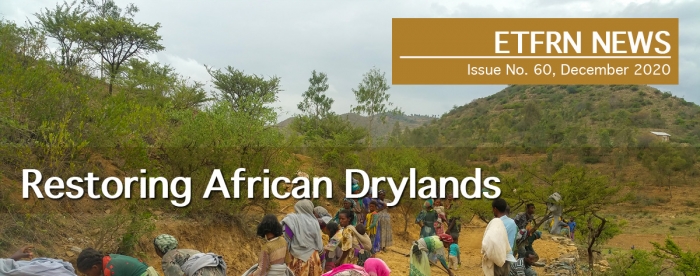At the beginning of the UN Decade on Ecosystem Restoration, this 60th issue of ETFRN News is very timely, reflecting a focus on drylands that cover some 40% of the world’s land area and contain some of the most severely degraded landscapes on Earth. They are also home to a third of the world’s population and a disproportionate number of the poorest people, along with unique ecosystems and biodiversity. And these issues are more acute in Africa than in any other continent.
 ETFRN News 60 focuses on dryland restoration in the Sahel and the Greater Horn of Africa where levels of poverty, land degradation and out-migration are acute. It collates 36 articles from more than 100 contributors, including some long-term analyses of remarkable increases in tree cover and improved agricultural yields over large areas of the Western Sahel never published before, landscape restoration in Ethiopia, and examples from many other countries.
ETFRN News 60 focuses on dryland restoration in the Sahel and the Greater Horn of Africa where levels of poverty, land degradation and out-migration are acute. It collates 36 articles from more than 100 contributors, including some long-term analyses of remarkable increases in tree cover and improved agricultural yields over large areas of the Western Sahel never published before, landscape restoration in Ethiopia, and examples from many other countries.
These provide new insights into what has led to the documented successes, summarizes the ‘top ten’ key findings, and offer recommendations to a much-needed change in focus if we are to achieve the ambitious commitments made by African countries to Land Degradation Neutrality targets, the Bonn Challenge, the African Forest Landscape Initiative, and the Great Green Wall, amongst others.
The overriding story is that farmer and community-led initiatives are the main driver of dryland restoration that have been adopted at scale, and at low cost. These include simple water harvesting techniques, encouraging natural regeneration, and locally-managed control over resources. Key factors include bylaws made with and enforced by local institutions and communities, the inclusion of women and youth, and effective support from projects and programmes, and national and international policies. Large-scale projects have also played a role, and private sector investments are limited but expanding.
There is an urgent need to take this knowledge on board in adapting and implementing restoration programmes. But challenges remain, such as tailoring investments to community needs so local people earn more from their efforts, and to improve monitoring to assess progress not just in productivity and hectares under restoration, but also in the resulting social, economic and environmental benefits.
Dryland degradation can be reversed, recreating more resilient and productive landscapes that will fix more carbon especially in the soil, restore ecosystem services, promote new viable enterprises and create employment, while reducing conflicts and migration. And together, these will increase the opportunities to meeting the Sustainable Development Goals and the targets of the Rio Conventions on desertification, climate change and biodiversity.
Download here the full volume
Download here individual articles
This edition of ETFRN News 60 is financed by the Ministry of Foreign Affairs of the Government of the Netherlands. It is co-published by The European Tropical Forest Research Network and Tropenbos International.

 ETFRN News 60 focuses on dryland restoration in the Sahel and the Greater Horn of Africa where levels of poverty, land degradation and out-migration are acute. It collates 36 articles from more than 100 contributors, including some long-term analyses of remarkable increases in tree cover and improved agricultural yields over large areas of the Western Sahel never published before, landscape restoration in Ethiopia, and examples from many other countries.
ETFRN News 60 focuses on dryland restoration in the Sahel and the Greater Horn of Africa where levels of poverty, land degradation and out-migration are acute. It collates 36 articles from more than 100 contributors, including some long-term analyses of remarkable increases in tree cover and improved agricultural yields over large areas of the Western Sahel never published before, landscape restoration in Ethiopia, and examples from many other countries.